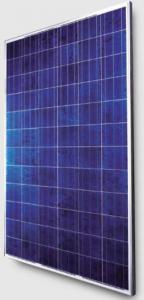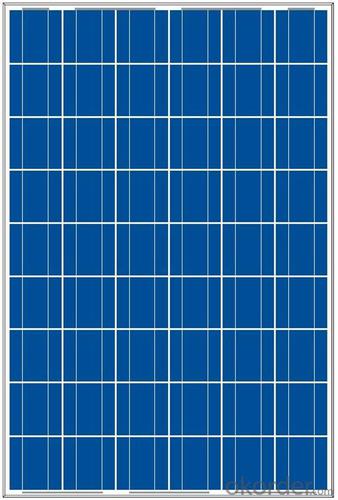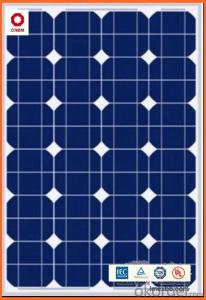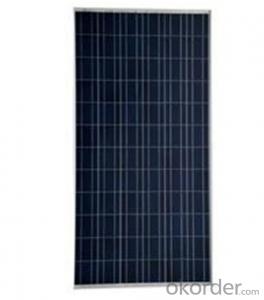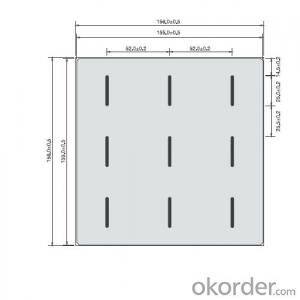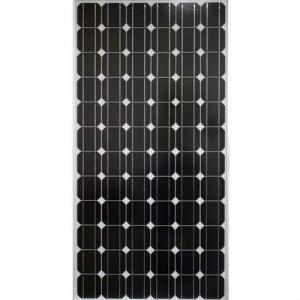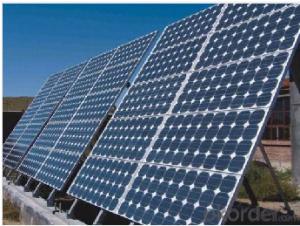High Efficiency TUV Rv Solar Cells Crystalline Silicon Solar Module
- Loading Port:
- China Main Port
- Payment Terms:
- TT or LC
- Min Order Qty:
- -
- Supply Capability:
- -
OKorder Service Pledge
OKorder Financial Service
You Might Also Like
Quick Details
| Quick Details | |||||
| Max. Power: | 1W to 300W | Surface Glass: | Tempered Glass | Model Number: | DBF, MBF |
| Frame: | Firm Aluminum | Warranty: | 25 years | Number of Cells: | 36 or 72 PCS |
| Packaging & Delivery | Glue: | EVA | Delivery Detail: | 15 days | |
| Packaging Detail: | Carton/Wooden Case/Pallet | Certificate: | TUV, CE | ||
Specifications
Mono and Poly Solar Module
1. CE, TUV, ISO
2. High efficiency and good warranty
3. Customized type 1W to 300W
4. OEM Service
We are professional manufacturer with ISO9001:2000 certificate for kinds of solar panels in China. Our main products include Crystalline Silicon solar panels, Amorphous Thin Film Silicon Solar panels, and BIPV products. Since 2001, we have been being in the sector of solar panels for 10 years. Our products are with high quality and at competitve price.
Our Advantages:
1) 10 years experience of solar module encapsulation.
2) 31MW solar module have been used in Chinese major grid-connected projects.
3) Be among the first Chinese enterprises to enter the Germany grid-connected market.
4) To build up a 1GW module encapsulation & integration capacity in 2015.
5) Own 45 patents and 3 module production bases in different cities.
We offer Polycrystalline Silicon and Monocrystalline Silicon Solar Module from 1W to 300W. Please feel free to advise us the size and specification you need.
Here is some information of our Crystalline Silicon Solar Panels for your reference.

FAQ
We have organized several common questions for our clients,may help you sincerely:
①what price for each watt?
it depends on the quantity, delivery date and payment terms,
②what is your size for each module? can you tell me the parameter of your module?
we have different series of panels in different output, both c-si and a-si. please take the specification sheet for your reference.
③Can you provide the peripheral products of the solar panels, such as the battery, controller, and inverter? If so, can you tell me how do they match each other?
Yes, we can, we have two companies for solar region, one is CNBM International, the other is CNBM engineering Co.
We can provide you not only the solar module but also Solar Cells, the off grid solar system, we can also provide you service with on grid plant.
④What is your warranty system?
Our product performance guarantees for 25 years
• 12 years guarantee for workmanship
• Timeliness of delivery
• Quality Products certified (TÜV, UL, CE, ISO)
⑤How do you pack your products?
We have rich experience on how to pack the panels to make sure the safety on shipment when it arrives at the destination.
⑥ Can you do OEM for us?
Yes, we can.
⑦How long can we receive the product after purchase?
In the purchase of product within three working days, We will arrange the factory delivery as soon as possible. The pecific time of receiving is related to the state and position of customers. Commonly 7 to 10 working days can be served.
- Q: Can solar cells be used at night?
- No, solar cells cannot generate electricity at night because they rely on sunlight to produce energy.
- Q: How do solar cells handle hail or other severe weather conditions?
- Solar cells are designed to withstand severe weather conditions including hail. They are made with durable materials such as tempered glass that can handle impact from hailstones. Additionally, solar panels are tested and rated for their ability to withstand extreme weather events, ensuring their resilience in harsh conditions.
- Q: Can solar cells be used in military vehicles or equipment?
- Yes, solar cells can be used in military vehicles or equipment. Solar power is a viable and sustainable energy source that can be harnessed to reduce reliance on traditional fuel sources and improve operational efficiency in military operations. Solar cells can be integrated into various military applications, including powering communication systems, surveillance equipment, and even electric vehicles, to enhance their capabilities and reduce their environmental impact.
- Q: How do solar cells perform in high pollution areas?
- Solar cells may be less efficient in high pollution areas due to the reduced amount of sunlight reaching the cells. The presence of pollutants in the air can block or scatter sunlight, decreasing the amount of light that solar cells can convert into electricity. Additionally, pollutants can accumulate on the surface of the cells, further reducing their performance. However, advancements in solar cell technology and regular cleaning can help mitigate the negative effects of pollution, allowing solar cells to still generate electricity, albeit at a slightly lower efficiency.
- Q: Can solar cells be used in street lighting?
- Yes, solar cells can be used in street lighting. Solar-powered street lights utilize solar panels to convert sunlight into electricity, which is then stored in batteries. This stored energy is used to power the street lights during the night, making them a sustainable and cost-effective lighting solution for streets.
- Q: Can solar cells be used in concert venues?
- Yes, solar cells can be used in concert venues. They can be installed on the roofs or surrounding areas of the venue to capture solar energy and convert it into electricity. This renewable energy source can help power various systems within the venue, such as lighting, sound equipment, and other electrical needs, reducing the reliance on traditional energy sources and lowering the environmental impact of the venue.
- Q: How are solar cells installed on rooftops?
- Solar cells are typically installed on rooftops using a mounting system that secures the panels in place. This involves attaching metal brackets or rails onto the roof, which act as the support structure for the solar panels. The panels are then placed onto these brackets and secured using clamps or screws. The installation process requires careful positioning and alignment to ensure maximum sunlight exposure for efficient energy generation.
- Q: Can solar cells be used in museums?
- Yes, solar cells can be used in museums. They can be used to power various exhibits, displays, and lighting systems, providing a sustainable and renewable energy source. Additionally, solar cells can be integrated into the building's architecture, blending aesthetics with functionality, and reducing the museum's carbon footprint.
- Q: How much land is required to install solar cells?
- The amount of land required to install solar cells depends on various factors such as the capacity of the solar system, efficiency of the solar panels, and the power generation goals. On average, it is estimated that a 1 MW solar power plant requires about 4-5 acres of land. However, with advancements in solar technology, the land requirements are decreasing as solar panels become more efficient and produce more power per square foot.
- Q: What is the impact of snowmelt on solar cell efficiency?
- The impact of snowmelt on solar cell efficiency is generally positive. When snow covers solar panels, it reduces their ability to generate electricity due to the lack of sunlight reaching the cells. However, as the snow melts and slides off the panels, it allows for maximum exposure to sunlight, thus improving the efficiency and energy production of the solar cells.
Send your message to us
High Efficiency TUV Rv Solar Cells Crystalline Silicon Solar Module
- Loading Port:
- China Main Port
- Payment Terms:
- TT or LC
- Min Order Qty:
- -
- Supply Capability:
- -
OKorder Service Pledge
OKorder Financial Service
Similar products
Hot products
Hot Searches
Related keywords

